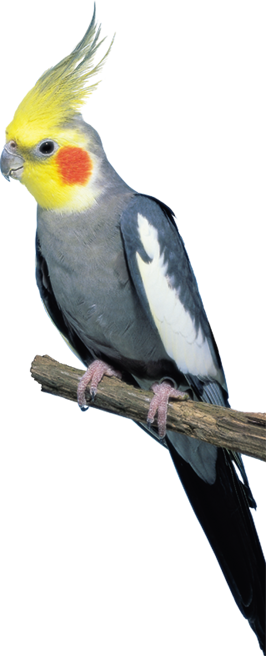Profiles
COCKATIEL
(Nymphicushollandicus), also known as Quarrion.
Family: Parrot
Origin: Widely distributed throughout Australia
Size: Length is 320mm including 170mm tail
Description:
These are delightful little birds and can be real chatterboxes once they feel completely confident with their owners and surroundings.
The cock bird usually sports grey feathers with paler under parts which is then all “washed” with brown. Its forehead, crest, throat and expression-filled face are yellow and its ear coverts are splashed with orange.
The wing coverts have white patches and the rump, upper tail coverts and central tail feathers are pale grey. Dark grey colours the outer feathers and underside of the tail.
For the hen the markings are usually as follows: the crown, crest and cheeks are a dull yellow tinged with grey and its ear coverts are a dull orange.
The rump, lower under parts and central tail feathers are pale grey while lightly marked with yellow. The outer tail feathers are also yellow and are barred with some grey. The immature chicks look similar to the hen.
Several other varieties of this glorious bird include “cinnamon”, “pied”, “lutino”, “pearl”, and “silver”.
Care:
Even if you are only planning to keep a single bird you will still need to provide it with a decent sized cage to allow it to freely move about. Give it at least two good perches made of wood from edible trees. Fresh drinking must be supplied each day.
And a wider rather than a taller cage is better because birds fly from side to side, not up and down.
If possible, the bird should be taken out of its cage each day and allowed to fly around the house for exercise.
If it is able to fly around the home make sure that all the windows are closed, curtains drawn (so it doesn’t crash into glass), no stoves are turned on or hot saucepans on the stove or benchtop (but ideally for safety reasons it’s best not to let the bird into kitchen), and if it can fly into the bathroom the bath should be empty and the toilet seats should be down.
If you are going to be breeding these birds a good-sized aviary with a “flight” attached and sited in a sheltered part of the garden would be best. You also need to be considerate of your neighbours and the council has laws relating to how big the aviary can be.
If you do not intend to show your birds, then colony breeding may be used in which case you will need to have several nest boxes in the aviary ensuring that two more boxes than there are pairs is supplied.
You should also place fresh water into the aviary daily along with fresh greens and be sure to remove any old food and seed husks.
Eats:
Good quality cockatiel mix consisting of millet, canary, sunflower, safflower, linseed, hulled oats, seeding grasses, fruit, vegetables, grit, a cuttlefish bone along with calcium and iodine blocks. Do not feed avocado as this is poisonous to most birds.
Features:
The incubation period for this bird is 18 to 20 days and the chicks remain in the nest for five weeks at which time they are fed by both parents.
Call:
Whether a cock or a hen, the cockatiel has a prolonged “queel-queel” sounding call with an upward inflection repeated four or five times followed by a pause . . . and then repeated again.
Personality:
It possesses a sweet and gentle nature and is quite easy to tame so long as you show it plenty of love and kindness. They can also be taught to talk reasonably quickly.
